American Music美国音乐介绍精编版
- 格式:ppt
- 大小:6.16 MB
- 文档页数:13
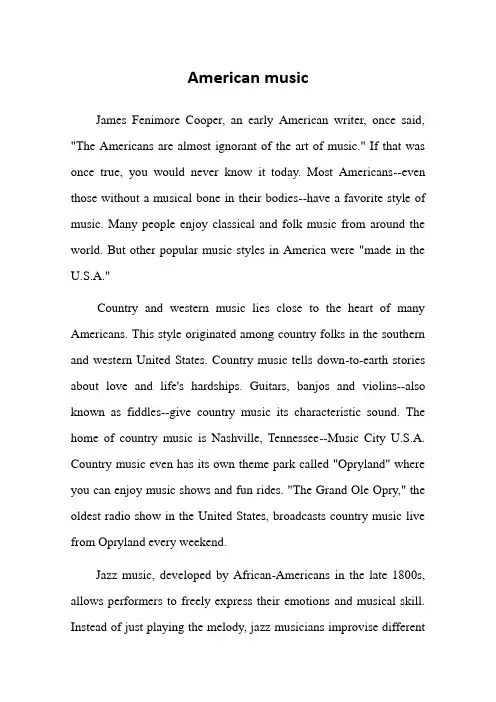
American musicJames Fenimore Cooper, an early American writer, once said, "The Americans are almost ignorant of the art of music." If that was once true, you would never know it today. Most Americans--even those without a musical bone in their bodies--have a favorite style of music. Many people enjoy classical and folk music from around the world. But other popular music styles in America were "made in the U.S.A."Country and western music lies close to the heart of many Americans. This style originated among country folks in the southern and western United States. Country music tells down-to-earth stories about love and life's hardships. Guitars, banjos and violins--also known as fiddles--give country music its characteristic sound. The home of country music is Nashville, Tennessee--Music City U.S.A. Country music even has its own theme park called "Opryland" where you can enjoy music shows and fun rides. "The Grand Ole Opry," the oldest radio show in the United States, broadcasts country music live from Opryland every weekend.Jazz music, developed by African-Americans in the late 1800s, allows performers to freely express their emotions and musical skill. Instead of just playing the melody, jazz musicians improvise differenttunes using the same chords. The peak of jazz music came in the 1920s, known as "The Jazz Era." This period produced musicians like Louis Armstrong, Benny Goodman and Duke Ellington. These musicians later created the "big band" sounds of the 1930s. Different styles of jazz developed in different cities, such as New Orleans, Chicago, New York and Kansas City. Composer George Gershwin brought jazz into the world of classical music with pieces like "Rhapsody in Blue."The 1950s saw the development of an explosive new music style: rock 'n' roll. Performers like Elvis Presley and songs of Bill Haley made rock music widely popular. This powerful music style addresses issues like love, sex, drugs, politics and death. Often it rebels against the accepted values of society. Rock concerts, featuring loud music and sometimes weird stage acts, have become a major part of American youth culture. Music videos on television have spread the message of rock to the far corners of the globe.。

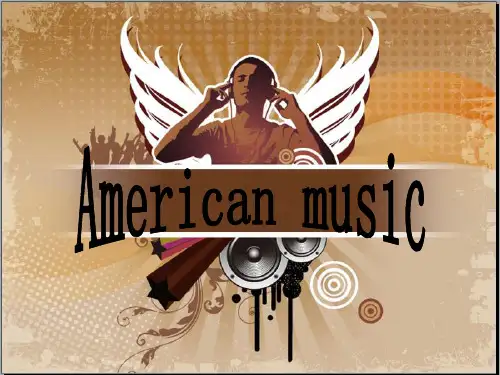
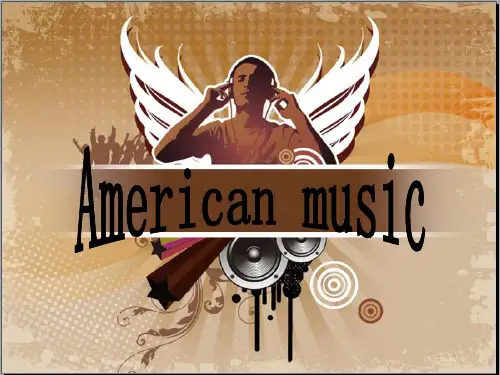
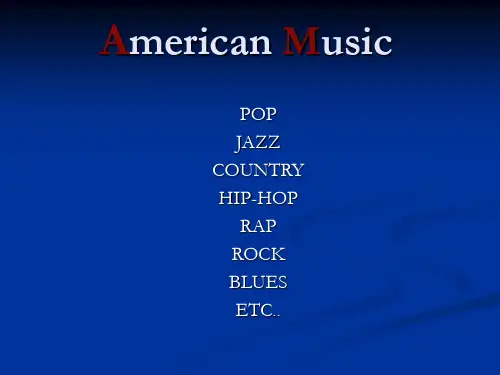
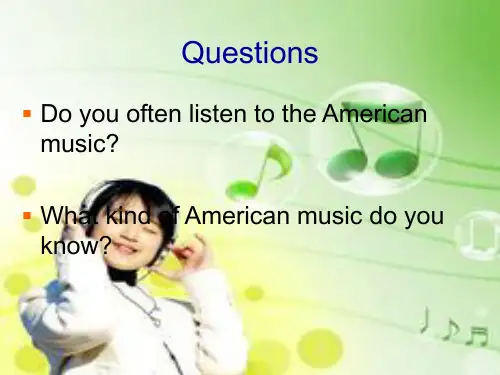

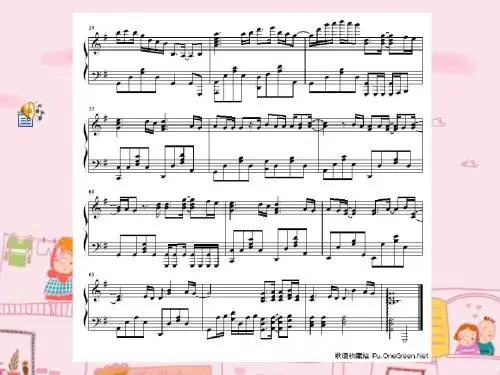

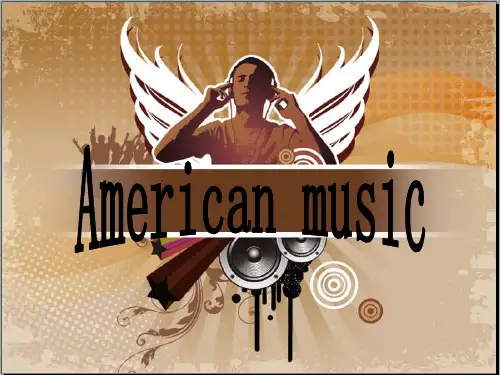
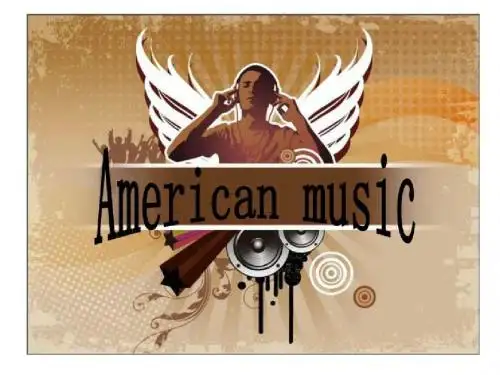
有关介绍美国的英语文章美国,一直以来都保持着超级大国的地位,对世界有着巨大的影响力。
今天店铺在这里为大家分享有关介绍美国的英语文章,欢迎大家阅读!有关介绍美国的英语文章篇一Music 美国人的音乐爱好James Fenimore Cooper, an early American writer, once said, "The Americans are almost ignorant of the art of music." If that was once true, you would never know it today. Most Americans——even those without a musical bone in their bodies——have a favorite style of music. Many people enjoy classical and folk music from around the world. But other popular music styles in America were "made in the U.S.A."一位美国早期的作家柯柏(James Fenimore Cooper)曾说:「美国人对音乐艺术几乎可以说是相当的无知。
」如果这话曾经是事实,今日你绝不会这么认为了。
大部份的美国人,甚至包括那些没有音乐细胞的人,都有自己喜爱的音乐型态。
许多人喜欢世界各国的古典音乐和民俗音乐,然而美国其它的流行音乐则是「在美国制造」的。
Country and western music lies close to the heart of many Americans. This style originated among country folks in the southern and western United States. Country music tells down-to-earth stories about love and life's hardships. Guitars, banjos and violins——also known as fiddles——give country music its characteristic sound. The home of country music is Nashville, Tennessee——Music City U.S.A. Country music even has its own theme park called "Opryland" where you can enjoy music shows and fun rides. "The Grand Ole Opry," the oldest radio show in the United States, broadcasts country music live from Opryland every weekend.乡村和西部音乐深得很多美国人的人心,这种型态的音乐起源于美国南部和西部的乡村小民们。
CharacteristicsThe music of the United States can be characterized by the use of syncopation and asymmetrical rhythms, long, irregular melodies, which are said to "reflect the wide open geography of (the American landscape)" and the "sense of personal freedom characteristic of American life".[2] Some distinct aspects of American music, like the call-and-response format, are derived from African techniques and instruments.Throughout the later part of American history, and into modern times, the relationship between American and European music has been a discussed topic among scholars of American music. Some have urged for the adoption of more purely European techniques and styles, which are sometimes perceived as more refined or elegant, while others have pushed for a sense of musical nationalism that celebrates distinctively American styles. Modern classical music scholar John Warthen Struble has contrasted American and European, concluding that the music of the United States is inherently distinct because the United States has not had centuries of musical evolution as a nation. Instead, the music of the United States is that of dozens or hundreds of indigenous and immigrant groups, all of which developed largely in regional isolation until the American Civil War, when people from across the country were brought together in armyunits, trading musical styles and practices. Struble deemed the ballads of the Civil War "the first American folk music with discernible features that can be considered unique to America: the first 'American' sounding music, as distinct from any regional style derived from another country."[3]The Civil War, and the period following it, saw a general flowering of American art, literature and music. Amateur musical ensembles of this era can be seen as the birth of American popular music. Music author David Ewen describes these early amateur bands as combining "the depth and drama of the classics with undemanding technique, eschewing complexity in favor of direct expression. If it was vocal music, the words would be in English,amateur piano and singing were considered proper for middle- and upper-class women, who were, nevertheless, frequently barred from orchestras and symphonies. Women were also a major part of early popular music performance, though recorded traditions quickly become more dominated by men. Most male-dominated genres of popular music include female performers as well, often in a niche appealing primarily to women; these include gangsta rap and heavy metal.[11]DiversityThe United States is often said to be a cultural melting pot, taking in influences from across the world and creating distinctively new methods of cultural expression. Though aspects of American music can be traced back to specific origins, claiming any particular original culture for a musical element is inherently problematic, due to the constant evolution of American music through transplanting and hybridizing techniques, instruments and genres. Elements of foreign musics arrived in the United States both through the formal sponsorship of educational and outreach events by individuals and groups, and through informal processes, as in the incidental transplantation of West African music through slavery, and Irish music through immigration. The most distinctly American musics are a result of cross-cultural hybridization through close contact. Slavery, for example, mixed persons from numerous tribes in tight living quarters, resulting in a shared musical tradition that was enriched through further hybridizing with elements of indigenous, Latin and European music.[12] American ethnic, religious and racial diversity has also produced such intermingled genres as the French-African music of the Louisiana Creoles, the Native, Mexican and European fusion Tejano music and the thoroughly hybridized slack-key guitar and other styles of modern Hawaiian music.The process of transplanting music between cultures is not without criticism. The folk revival of the mid-20th century, for example, appropriated the musics of various rural peoples, in part to promote certain political causes, which has caused some to question whether the process caused the "commercial commodification of other peoples' songs... and the inevitable dilution of mean" in the appropriated musics. The issue of cultural appropriation has also been a major part of racial relations in the United States. The use of African American musical techniques, images and conceits in popular music largely by and for white Americans has been widespread since at least the mid-19th century songs of Stephen Foster and the rise of minstrel shows. The American music industry has actively attempted to popularize white performers of African American music because they are more palatable to mainstream and middle-class Americans. This process has produced such varied stars as Benny Goodman,"Bice'waan Song"This is an 1897 recording of a traditional Omaha courtship song. "On the Old Kissimmee Prairie"This is a British tune recorded in Florida in 1940"The Old Grey Mare"This is old-time Appalachian folk music from 1925."Dollar Mamie"This is a work song for hoeing, recorded at Mississippi State Penitentiary in 1939."Caminode San Antonio"This is a corrido, recorded near Brownsville, Texas in 1939."Cotton-Eyed Joe"Cotton-Eyed Joe is a traditional folk song and a line dance mostly known in the Southern United StatesThe ancestors of today's African American population were brought to the United States as slaves, working primarily in the plantations of the South. They were from hundreds of tribes across West Africa, and they brought with them certain traits of West African music including call and response vocals and complexly rhythmic music,[18] as well as syncopated beats and shifting accents.[19] The African musical focus on rhythmic singing and dancing was brought to the New World, and where it became part of a distinct folk culture that helped Africans "retain continuity with their past through music". The first slaves in the United States sang work songs, field hollers[20] and, following Christianization, hymns. In the 19th century, a Great Awakening of religious fervor gripped people across the country, especially in the South. Protestant hymns written mostly by New England preachers became a feature of camp meetings held among devout Christians across the South. When blacks began singing adapted versions of these hymns, they were called Negro spirituals. It was from these roots, of spiritual songs, work songs and field hollers, that blues, jazz and gospel developed.Blues and spiritualsSpirituals were primarily expressions of religious faith, sung by slaves on southern plantations.[21] In the mid to late 19th century, spirituals spread out of the U.S. South. In 1871 Fisk University became home to the Jubilee Singers, a pioneering group that popularized spirituals across the country. In imitation of this group, gospel quartets arose, followed by increasing diversification with the early 20th-century rise of jackleg and singing preachers, from whence came the popular style of gospel music.Blues is a combination of African work songs, field hollers and shouts.[22]It developed in the rural South in the first decade of the 20th century. The most important characteristics of the blues is its use of the blue scale, with a flatted or indeterminate third, as well as the typically lamenting lyrics; though both of these elements had existed in African American folk music prior to the 20th century, the codified form of modern blues (such as with the AAB structure) did not exist until the early 20th century.[23]Other immigrant communitiesThe United States is a melting pot consisting of numerous ethnic groups. Many of these peoples have kept alive the folk traditions of their homeland, often producing distinctively American styles of foreign music. Some nationalities have produced local scenes in regions of the country where"The Star-Spangled Banner"The Star-Spangled Banner performed by Fred Waring and his Pennsylvanians (1942)"Stars and Stripes Forever"John Phillip Sousa's Stars and Stripes Forever. Performed by the United States Marine Corps band"Dixie"1916 rendition of Dixie by the Metropolitan Mixed Chorus with Ada Jones and Billy MurrayAudio samples of blues-derived early popular musicRagtime composition by Scott Joplin[[:Image:|"Down by the Riverside"]][[Image:|180px|noicon]]Popular song by gospel singer Mahalia JacksonThe blues is a genre of African American folk music that is the basis for much of modern American popular music. Blues can be seen as part of a continuum of musical styles like country, jazz, ragtime, and gospel; though each genre evolved into distinct forms, their origins were often indistinct. Early forms of the blues evolved in and around the Mississippi Delta in the late 19th and early 20th centuries. The earliest blues-like music was primarily call-and-response vocal music, without harmony or accompaniment and without any formal musical structure. Slaves and their descendants created the blues by adapting the field shouts and hollers, turning them into passionate solo songs.[50]When mixed with the ChristianDavis were rediscovered. The seminal blues artists of these periods had tremendous influence on rock musicians such as Chuck Berry in the 1950s, as well as on the British blues and blues-rock scenes of the 1960s and '70s, including among others Eric Clapton in Britain and Johnny Winter in Texas.JazzAudio samples of jazzJazz is a kind of music characterized by swung and blue notes, call and response vocals, polyrhythms and improvisation. Though originally a kind of dance music, jazz has been a major part of popular music, and has also become a major element of Western classical music. Jazz has roots in West African cultural and musical expression, and in African American music traditions including blues and ragtime, as well as European military band music.[55] Early jazz was closely related to ragtime, with which it could be distinguished by the use of more intricate rhythmic improvisation. The earliest jazz bands adopted much of the vocabulary of the blues, including bent and blue notes and instrumental "growls" and smears otherwise not used on European instruments. Jazz's roots come from the city of New Orleans, Louisiana, populated by Cajuns and black Creoles, who combined the French-Canadian culture of the Cajuns with their own styles of music in the 19th century. Large Creole bands that played for funerals and parades became a major basis for early jazz, which spread from New Orleans to Chicago and other northern urban centers.Bebop pioneer Dizzy Gillespie"I Walk the Line"Song by popular country performer Johnny Cash "Killin' Time"Pop-country song by Clint Black"Papa's Got a Brand New Bag"Groundbreaking hit song by soul/funk pioneer James Brown"Ready or Not, Here I Come (Can't Hide From Love)"Hit song by '60s Philly soul act The Delfonics[[:Image:{{{filename}}}|"What's Going On"]] [[Image:{{{filename}}}|180px|noicon]]Innovative song by album-oriented soul singer-songwriter Marvin Gaye"Good Rockin' Tonight"By Elvis Presley, a crossover rockabilly performer "Because the Night"Major hit by rock singer Patti Smith "Debaser"Song by alternative rock band the Pixies "Enter Sandman"By the band Metallica"Come as You Are"Song by grunge crossover band Nirvanafounder of the Archive of American Folk Song, and John and Alan Lomax; Alan Lomax was the most prominent of several folk song collectors who helped to inspire the 20th century roots revival of American folk culture.[101]Early 20th scholarly analysis of American music tended to interpret European-derived classical traditions as the most worthy of study, with the folk, religious and traditional musics of the common people denigrated as low-class and of little artistic or social worth. American music history was compared to the much longer historical record of European nations, and was found wanting, leading writers like the composer Arthur Farwell to ponder what sorts of musical traditions might arise from American culture, in his 1915 Music in America. In 1930, John Tasker Howard's Our American Music became a standard analysis, focusing on largely on concert music composed in the United States.[102] Since the analysis of musicologist Charles Seeger in the mid-20th century, American music history has often been described as intimately related to perceptions of race and ancestry. Under this view, the diverse racial and ethnic background of the United States has both promoted a sense of musical separation between the races, while still fostering constant acculturation, as elements of European, African and indigenous musics have shifted between fields.[100]Gilbert Chase's America's Music, from the Pilgrims to the Present, was the first major work to examine the music of the entire United States, and recognize folk traditions as more culturally significant than music for the concert hall. Chase's analysis of a diverse American musical identity has remained the dominant view among the academic establishment.[102] Until the 1960s and 70s, however, most musical scholars in the United States continued to study European music, limiting themselves only to certain fields of American music, especially European-derived classical and operatic styles, and sometimes African American jazz. More modern musicologists and ethnomusicologists have studied subjects ranging from the national musical identity to the individual styles and techniques of specific communities in a particular time of American history.[100] Prominent recent studies of American music include Charles Hamm's Music in the New World from 1983, and Richard Crawford's America's Musical Life from 2001.[103]Holidays and festivalsAudio samples of Christmas music"Jingle Bells"Secular Christmas song"O Holy Night"Religious Christmas song∙Baraka, Amiri (Leroi Jones) (1963). Blues People: Negro Music in White America, William Morrow. ISBN 0-688-18474-X.∙Blush, Steven (2001). American Hardcore: A Tribal History, Feral House. ISBN 0-92291-571-7.∙Chase, Gilbert (2000). America's Music: From the Pilgrims to the Present, University of Illinois Press. ISBN 0-252-00454-X.∙Clarke, Donald (1995). The Rise and Fall of Popular Music, St.Martin's Press. ISBN 0-312-11573-3.∙Collins, Ace (1996). The Stories Behind Country Music's All-Time Greatest 100 Songs, Boulevard Books. ISBN 1-57297-072-3.∙Crawford, Richard (2001). America's Musical Life: A History, W. W.Norton & Company. ISBN 0-393-04810-1.∙Ewen, David (1957). Panorama of American Popular Music, Prentice Hall.∙Ferris, Jean (1993). America's Musical Landscape, Brown & Benchmark.ISBN 0-697-12516-5.∙Koskoff, Ellen (ed.), ed. (2000). Garland Encyclopedia of World Music, Volume 3: The United States and Canada, Garland Publishing.ISBN 0-8240-4944-6.∙Garofalo, Reebee (1997). Rockin' Out: Popular Music in the USA, Allyn & Bacon. ISBN 0-205-13703-2.∙Gillett, Charlie (1970). The Sound of the City: The Rise of Rock and Roll. cited in Garofalo, Outerbridge and Dienstfrey. ISBN 0-285-62619-1.∙Nelson, George (2007). Where Did Our Love Go?: The Rise and Fall of the Motown Sound?. New York: University of Illinois Press. ISBN 9780252074981.∙Kempton, Arthur (2003). Boogaloo: The Quintessence of American Popular Music. New York: Pantheon Books. ISBN 0-375-42172-6.∙Lipsitz, George (1982). Class and Culture in Cold War America, J.F. Bergin. ISBN 0-03-059207-0.∙Malone, Bill C. (1985). Country Music USA: Revised Edition. cited in Garofalo, University of Texas Press. ISBN 0-292-71096-8.∙Nettl, Bruno (1965). Folk and Traditional Music of the Western Continents, Prentice-Hall.∙Palmer, Robert (April 19, 1990). "The Fifties". Rolling Stone: 48. ∙Ward, Ed, Geoffrey Stokes and Ken Tucker (1986). Rock of Ages: The Rolling Stone History of Rock and Roll, Rolling Stone Press. ISBN 0-671-54438-1.∙Broughton, Simon and Ellingham, Mark with McConnachie, James and Duane, Orla (Ed.) (2000). Rough Guide to World Music, Rough Guides Ltd, Penguin Books. ISBN 1-85828-636-0.∙Sawyers, June Skinner (2000). Celtic Music: A Complete Guide, Da Capo Press. ISBN 0-306-81007-7.∙Schuller, Gunther (1968). Early Jazz: Its Roots and Musical Development, Oxford University Press. ISBN 0-19-504043-0.∙Struble, John Warthen (1995). The History of American Classical Music, Facts on File. ISBN 0-816-02927-X.∙David Szatmary (2000). Rockin' in Time: A Social History of Rock-And-Roll, Prentice Hall. ISBN 0-13-022636-X.∙Werner, Craig (1998). A Change Is Gonna Come: Music, Race and the Soul of America, Plume. ISBN 0-452-28065-6.。